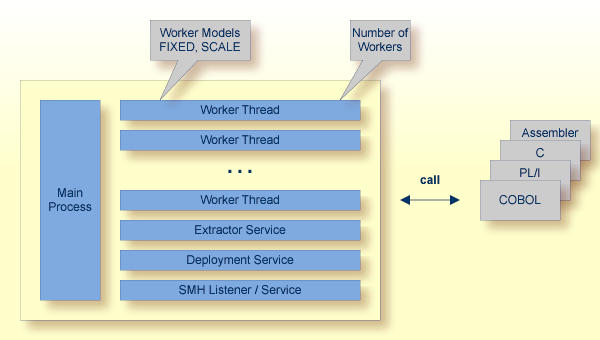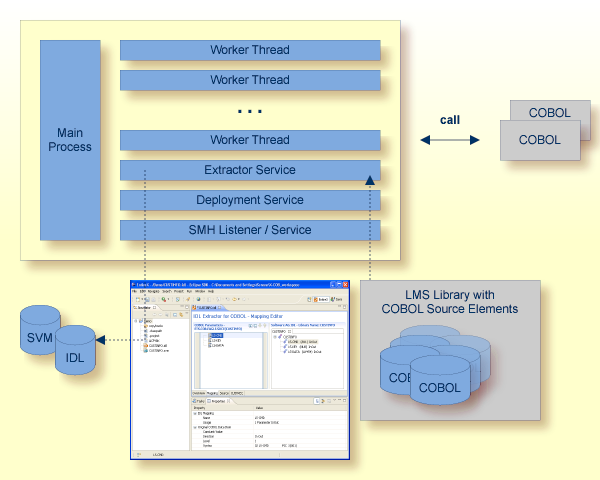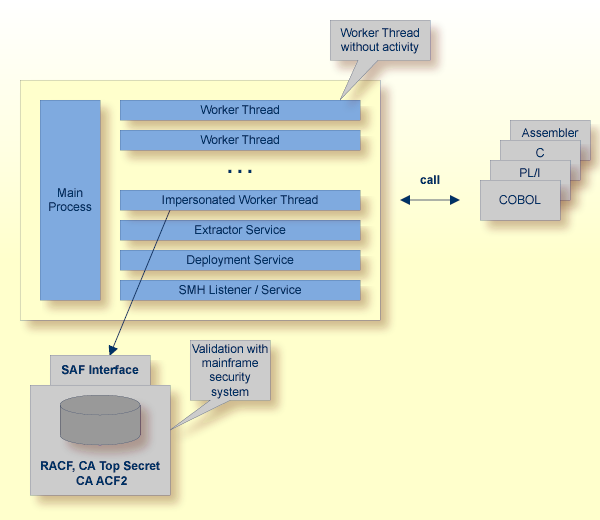The EntireX z/OS Batch RPC Server allows standard RPC clients to communicate with RPC servers on the operating system z/OS running in batch mode. It supports the programming languages COBOL, PL/I and C.
This document covers the following topics:
This section covers the following topics:

RPC requests are worked off inside the RPC server in worker threads, which are controlled by a main thread. Every RPC request occupies during its processing a worker thread. If you are using RPC conversations, each RPC conversation requires its own thread during the lifetime of the conversation. The Batch RPC Server provides two worker models:
FIXED
The fixed model creates a fixed number of worker threads.
The number of worker threads does not increase or decrease during the lifetime of an RPC server instance.
SCALE
The scale model creates worker threads depending on the incoming load of RPC requests.
A maximum number (thru value of the workermodel parameter)
of worker threads created can be set to restrict the system load.
The minimum number (from value of the workermodel parameter),
allows you to define a certain number of threads - not used by the currently executing RPC request -
to wait for new RPC client requests to process.
In this way the RPC server is ready to handle many RPC client requests arriving at the same time.
See parameter workermodel under Configuring the RPC Server.
Batch RPC Server provides several services for ease-of-use:
The Extractor Service is a prerequisite for remote extractions with the IDL Extractor for COBOL and IDL Extractor for PL/I. See Extractor Service for more information.

The Deployment Service allows you to deploy server mapping files (SVM files) interactively using the Deployment Wizard (see Server Mapping Deployment). On the RPC server side, the SVM files are stored in a VSAM file as the container. See Deployment Service for configuration information.

With the SMH Listener Service you use the System Management Hub to monitor the RPC server. See Administering the EntireX RPC Servers using System Management Hub under UNIX | Windows.
The SMH Service is switched on if the parameter smhport is set. See parameter smhport under Configuring the RPC Server.


The Batch RPC Server can be configured so that worker threads authenticate the RPC client user ID
before execution of the RPC request request with a mainframe security repository
(RACF, CA Top Secret or CA ACF2), using the SAF interface.
If the RPC user ID is valid, the worker thread gets the identity
of the RPC client. This is necessary when accessing (security) protected data sets,
for example with the Extractor Service.
The way authentication is carried out can be controlled by the RPC parameter
impersonation.
For impersonation value AUTO, the Batch RPC Server does not validate RPC passwords, so you have to make sure the RPC client is
correctly authenticated, either by using a secure EntireX Broker (validation must be against the correct mainframe security
repository where z/OS user IDs are defined) or with your own security implementation.
For impersonation value YES, the Batch RPC Server uses the RPC user ID and password supplied by the RPC client for authentication and impersonation of
the client.
This means that the RPC server validates the password.
The picture above shows the configuration impersonation=yes.
The lifetime of an impersonated task starts when an open request for an RPC conversation or a non-conversational RPC request is received. It ends when the RPC conversation stops (after a commit operation or timeout) or when the non-conversational RPC request has been performed.
To correctly support special COBOL syntax such as JUSTIFIED,
SYNCHRONIZE and OCCURS DEPENDING ON clauses, LEVEL-88 fields, etc.,
the Batch RPC Server requires in many situations a server mapping file.
SVM files contain COBOL-specific mapping information that is not included in the IDL file and therefore not sent by an EntireX RPC client to the RPC server. See also When is an SVM File Required? under Handling SVM Files.

The RPC server marshalls the data in a two-step process: the RPC request coming from the RPC client (Step 1) is completed with COBOL-specific mapping information taken from the SVM file (Step 2). In this way the COBOL server can be called as expected.
The SVM files are retrieved as a result of the IDL Extractor for COBOL extraction process and the COBOL Wrapper if a COBOL server is generated.
You can customize the usage of the SVM file using parameter
svm. See Configuring the RPC Server.
Note:
SVM files are used for COBOL only.
![]() To call an existing COBOL server
To call an existing COBOL server
Use the IDL Extractor for COBOL to extract the Software AG IDL and, depending on the complexity of the extraction, also an SVM file.
Build an EntireX RPC client using any EntireX wrapper. See EntireX Wrappers. For a quick test you can:
use the IDL Tester; see EntireX IDL Tester in the EntireX Workbench documentation
generate an XML mapping file (XMM) and use the XML Tester for verification; see EntireX XML Tester
See Client and Server Examples for z/OS Batch for COBOL RPC Server examples.
![]() To write a new COBOL server
To write a new COBOL server
Use the COBOL Wrapper to generate a COBOL server skeleton and, depending on the complexity of the extraction, also an SVM file. Write your COBOL server and proceed as described under Using the COBOL Wrapper for the Server Side.
Build an EntireX RPC client using any EntireX wrapper. See EntireX Wrappers. For a quick test you can:
use the IDL Tester; see EntireX IDL Tester in the EntireX Workbench documentation
generate an XML mapping file (XMM) and use the XML Tester for verification; see EntireX XML Tester
See Client and Server Examples for z/OS Batch for COBOL RPC Server examples.
![]() To call an existing PL/I server
To call an existing PL/I server
Use the IDL Extractor for PL/I to extract the Software AG IDL.
Build an EntireX RPC client using any EntireX wrapper. See EntireX Wrappers. For a quick test you can:
use the IDL Tester; see EntireX IDL Tester in the EntireX Workbench documentation
generate an XML mapping file (XMM) and use the XML Tester for verification; see EntireX XML Tester
See Client and Server Examples for z/OS Batch for PL/I RPC Server examples.
![]() To write a new PL/I server
To write a new PL/I server
Use the PL/I Wrapper to generate a PL/I server skeleton. Write your PL/I server and proceed as described under Using the PL/I Wrapper for the Server Side.
Build an EntireX RPC client using any EntireX wrapper. See EntireX Wrappers. For a quick test you can:
use the IDL Tester; see EntireX IDL Tester in the EntireX Workbench documentation
generate an XML mapping file (XMM) and use the XML Tester for verification; see EntireX XML Tester
See Client and Server Examples for z/OS Batch for PL/I RPC Server examples.
![]() To write a new C server
To write a new C server
Use the C Wrapper to generate a C server skeleton and a C server interface object. Write your C server and proceed as described under Using the C Wrapper for the Server Side (z/OS, UNIX, Windows, BS2000/OSD, IBM i).
Build an EntireX RPC client using any EntireX wrapper. See EntireX Wrappers. For a quick test you can:
use the IDL Tester; see EntireX IDL Tester in the EntireX Workbench documentation
generate an XML mapping file (XMM) and use the XML Tester for verification; see EntireX XML Tester
![]() To write a new Assembler (IBM 370) server
To write a new Assembler (IBM 370) server
Build an RPC server in Assembler. Here are some hints:
The RPC server is dynamically callable (no pre-initialization required).
The parameter interface is either compatible with the COBOL or PL/I calling convention (IDL level parameter will be passed
in the address list).
Configure the parameter marshalling accordingly for COBOL or PL/I.
The alignment of integer or float data types is considered. The HASM Assembler aligns integer or float data types to appropiate boundaries. For example:
...
MyLabel DSECT
MyField1 DS H I2
MyField2 DS F I4
MyField3 DS E F4
MyField4 DS L F8The Batch RPC Server will not align these data types by default.
To force alignment by definition in your IDL file
(see the aligned attribute within the attribute-list) before generating your RPC client.
For information on whether your client supports the aligned attribute, see Mapping the aligned Attribute to
C |
COBOL |
DCOM |
.NET |
Java |
Natural |
PL/I.
Build an EntireX RPC client using any EntireX wrapper. See EntireX Wrappers. For a quick test you can:
use the IDL Tester; see EntireX IDL Tester in the EntireX Workbench documentation
generate an XML mapping file (XMM) and use the XML Tester for verification; see EntireX XML Tester
See Returning Application Errors from a Server under z/OS Batch to a Client in the COBOL Wrapper documentation under Writing Applications with the COBOL Wrapper.